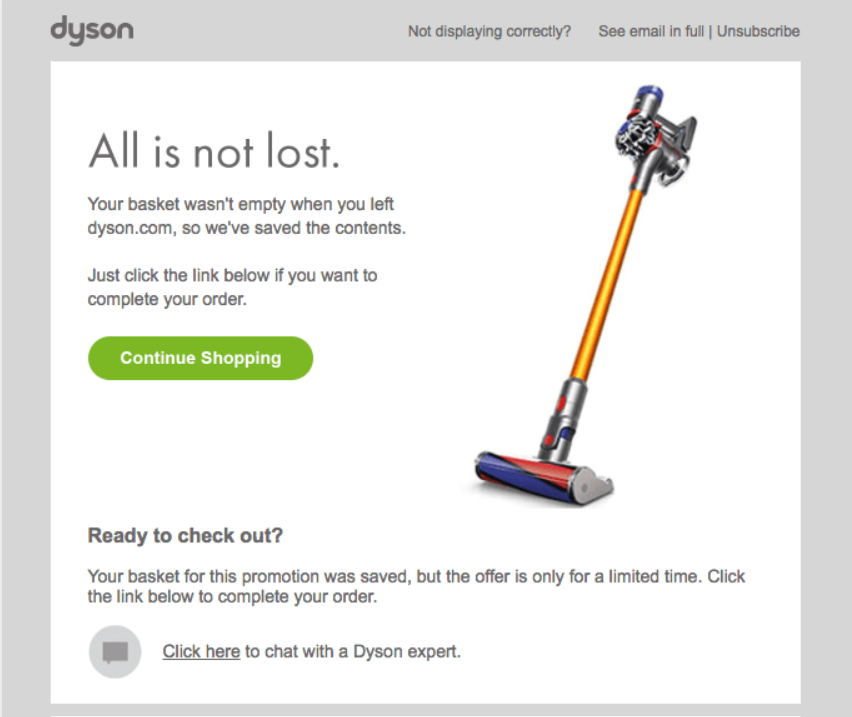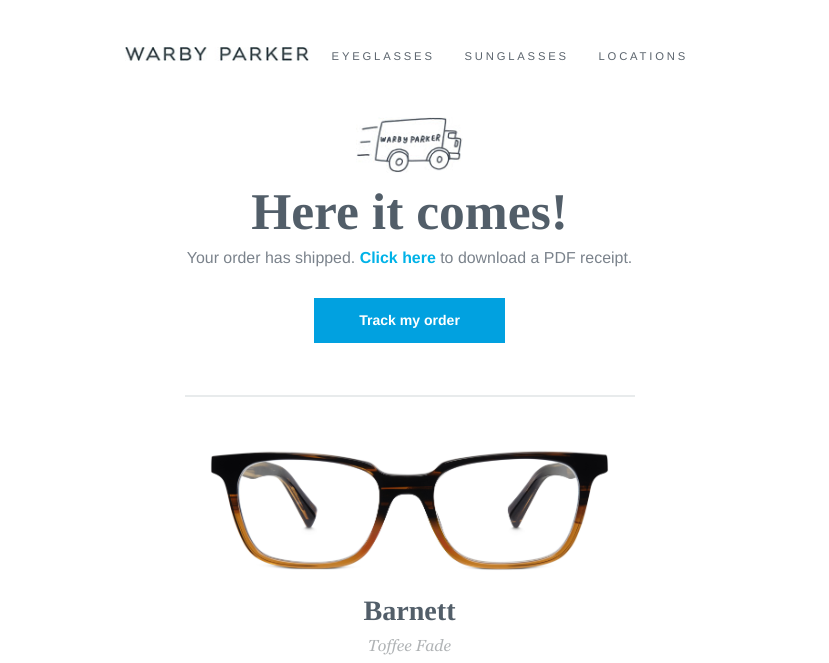3 Powerful Marketing Automation Tactics to Improve Your E-commerce Customer Experience

Reading Time: 7 minutes
When people imagine their ideal retail experience, they envision deeply personalized service. Perhaps a tailor measures the perfect fit for a suit, or a seamstress carefully determines the best dimensions for a dress.
Jeff Bezos used a slightly different analogy when he said of Amazon, “We see our customers as invited guests to a party, and we are the hosts. It’s our job every day to make every important aspect of the customer experience a little better.”
People still crave personalized shopping experiences. But instead of tailors or seamstresses, marketers are the purveyors of the customer experience. Instead of measuring tape, we use data to make the right suggestions for our customers.
And we deliver those recommendations through marketing automation.
Bonus Content:
|
Automation and the ROI of Customer Experience
Marketing automation isn’t exactly an emerging technology. Rather, it’s the smart application of this software that’s revolutionizing e-commerce.
Too many marketers still use automation as a way to push endless amounts of email when it’s really a tool for personalizing the customer experience. The items that are displayed on a page, the offers that pop up on our sites, and yes, the emails we send, are all part of the customer experience.
There’s an army of statistics that support the ROI of better customer experience, but here’s one that stands out: Customers who have excellent experiences with a business will spend 140% more with that business compared to consumers who had the poorest experiences.
So there it is. That’s a quantifiable value for delivering a better customer experience.
But how can you use automation to make strides toward that customer experience? You’re not Amazon; you don’t have an army of analysts or space-age AI to call on.
Never fear. Automation has been around long enough that there are well-established tactics you can use to immediately improve your customer experience.
Marketing Automation Tactics for your E-commerce
For improving your customer experience, 3 powerful marketing automation tactics in e-commerce are listed below:
1. Segmentation
The foundation of a better customer experience is relevancy. Show people something that’s relevant to their interests, and they’ll probably take a closer look.
To be relevant in e-commerce, you have to segment your audience and customize your marketing for each group. Automation software makes it easy to segment by a number of data points, like demographic information, location, and even behavior.
Behavior is the one you really want to focus on. With other data points, you need to make educated guesses about the audience’s preferences, but with behavioral data, the audience is showing you what’s important to them.
Here are a few examples of behavior segments you can build right away:
VIPs: A lot of things fall under the 80/20 rule, and e-commerce is no different. A minority of your customers will account for most of your purchases.
And you want to show those frequent buyers you care about them so they’ll stay loyal to your brand. So, create a VIP segment and send these people special offers and discounts to show them how much you appreciate them.
Non-Engaged: People who buy once and then go dark probably require a special kind of offer before they come back and buy again.
Category Specific: The most straightforward type of behavioral segmentation. If people buy a certain type of product, chances are they’ll be interested in other similar products you have for sale.
Get deeper insights into segmentation and how it impacts your customer experience here.
2. Email
For digital marketing in general and e-commerce specifically, email is a veritable cash cow. A couple of years ago, the Direct Marketing Association found that email delivers an average return of 38:1, which was 50% higher than the previous year.
Email may seem like a relic compared to some of the current advertising channels, but like with segmentation, email has become substantially more sophisticated thanks to automation.
The problem is many e-commerce organizations only practice a primitive form of email marketing. To make sure you’re not in that company, here are some examples of automated emails you should be sending.
The Welcome Email: Welcome emails are a timeless example of the “right content at the right time” concept. Someone has just told you they want to receive emails from your company. Why would you not send one right away?
Plus, people open welcome emails opened at nearly 4 times the right of regular promotional emails. Remember how we’re trying to gather behavioral data for segmentation? This is the prime time.
When you sign up for Patagonia’s emails here’s what happens:

You’re immediately welcomed to the email list, with the promise of all types of useful content. And guess what? At the bottom of the email, Patagonia includes a lot of different calls to action.
When people click on those, they’re already telling Patagonia what they’re interested in before they’ve even purchased anything.

Don’t sleep on welcome emails.
The Abandoned Shopping Cart Email: Alright, there is absolutely no reason to send someone an abandoned cart email. Just think of the series of events that occur before someone abandoned their cart:
- Someone visited your website
- They looked around for a little while, maybe a long while
- This person made a decision about what they wanted and put it in their cart
Just because someone didn’t finish checking out doesn’t mean they don’t want to buy the product that’s in the cart.
Life is hectic, and people are fickle. There are a thousand reasons why people don’t finish the checkout process. Sending them a gentle reminder is a surefire way to not only show them that you care but also coax them to finish what they started.
Here’s how Dyson does it:

If you really want to make this tactic work, don’t stop at just one reminder. Sending a series of abandoned cart reminders could increase your order rate by over 131%.
The Order Confirmation Email: Here’s another important stat about email marketing: people engage with transactional emails at a significantly higher rate than regular promotional emails.
Like I mentioned earlier, when people do something online, like signing up for a list or ordering something, they expect there to be an immediate reaction from your company.
So like the welcome email, messages you send confirming someone’s order or updating them on shipping are fantastic opportunities to offer your customers something extra and increase their engagement.
Warby Parker sent me this when my glasses shipped:

Ok, cool. I know that my order is on the way, and I can track it. But when I scrolled to the bottom, I found a few other things waiting for me:

Because these transactional emails get such high open rates (Who doesn’t want to know when their order has shipped?) Warby Parker knows they can drive a ton of traffic, and get sales if they include a few strategic CTAs.
Bonus tip: Learn how you can improve the chances of your email landing in a user’s inbox in our email marketer’s survival guide.
3. Dynamic Content
To really personalize your marketing at scale—to do more than put someone’s first name in an email—you need an automation system that can deliver dynamic content.
I’m sure you’re familiar with how Amazon makes recommendations, and the right automation platform can put the same power in your hands. In fact, dynamic content and personalization are important user experience trends that are coming of age this year.
The technology works by using an AI-powered recommendation engine to identify similar patterns in user behavior and then make recommendations. The dynamic content each visitor sees reflects based on their past actions as well as the actions people similar to them have taken.
I know it sounds sophisticated, and that’s because it is. But marketing leading brands are already employing this tactic.
So when Zillow sends an email recommending homes you should look at, it’s using a recommendation engine to dynamically show you properties you might like:
Or when YouTube sends me push notifications about videos I might like, it uses the same approach to predict what I might like:
Earlier, I mentioned the power of relevance for e-commerce. When executed correctly, there’s nothing more relevant than dynamically generated product recommendations.
We’re in a golden age of e-commerce. Not too long ago, Emarketer predicted e-commerce sales would double between 2016 and 2020 in the U.S.
But the pace of innovation is swift, and if you want to keep up, you need to use the latest technology to optimize your customer experience. To achieve that goal, there’s no substitute for thoughtful applications of marketing automation.









